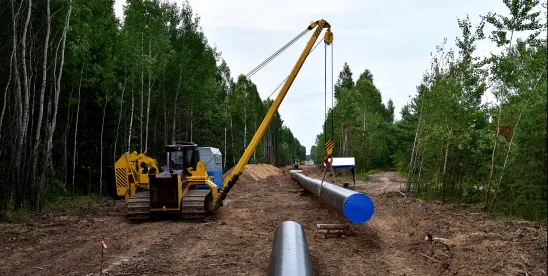Key Takeaways
- What Happened? The U.S. Environmental Protection Agency (EPA) issued its final Lead and Copper Rule Improvements (LCRI), marking a pivotal change in the regulation of lead in drinking water. This updated rule mandates full replacement of all lead service lines across the country within 10 years, with some limited exceptions, among other significant requirements. Notably, when a water system has access—whether legal or physical—to conduct a full replacement of lead or galvanized requiring replacement (GRR) service lines, it is considered to have control over the service line and must replace it under the LCRI. This can include lead service lines on a homeowner’s property. The LCRI is scheduled to be published in the Federal Register on October 30, 2024, and to take effect on December 29, 2024.
- Who Is Affected? All Community Water Systems and Non-Transient Non-Community Water Systems across the U.S. that have lead or GRR service lines are required to comply. A Community Water System is a public water system that serves at least 15 service connections used by year-round residents or regularly serves at least 25 year-round residents, such as public water authorities and private water companies. A Non-Transient Non-Community Water System is a public water system that is not a Community Water System but regularly serves at least 25 of the same people for over six months each year, such as schools, universities, and factories.
- Next Steps? EPA allows a three-year period for compliance with the LCRI. Affected entities should start developing a baseline service line inventory and a replacement plan, thoroughly understand the new requirements, create a staffing plan, and secure necessary funds for compliance. In the interim, the water systems should continue complying with the 2021 Lead and Copper Rule Revisions (LCRR) initial inventory requirements. Early preparation is essential to avoid noncompliance, especially since water systems have only three years to complete their baseline inventories.
Background on the LCRI
The LCRI is the latest in a series of updates to the original Lead and Copper Rule (LCR), first issued in 1991. While the initial LCR was designed to limit lead and copper levels in drinking water, over the years, regulators identified significant gaps in its effectiveness, particularly concerning lead service lines, which remain a major source of contamination.
In 2021, EPA introduced the LCRR, which required, among other things, that water systems submit an initial inventory of their lead service lines or demonstrate the absence of lead service lines by October 16, 2024. This requirement applies to all Community Water Systems and Non-Transient Non-Community Water Systems.
The initial inventory requirements of the LCRR specified that water systems must include detailed information in their initial service line inventory, submit their initial inventories to their primacy agency by the designated deadline, and ensure that their inventory information is publicly accessible. Additionally, water systems were required to notify all individuals served by the water system at service connections that contain lead, GRR, or lead status unknown service lines. The LCRR also outlined specific reporting requirements for states to promote compliance and transparency.
The LCRI takes a more aggressive approach than predecessor rulemakings by mandating full replacement of all lead service lines across the country within 10 years, regardless of current lead levels in the water, among other things.
The LCRI is part of EPA’s broader efforts under the Safe Drinking Water Act (SDWA) to promote clean and safe drinking water across the country. In parallel, EPA and state authorities are engaged in several key regulatory actions regarding drinking water, including:
- NPDWR for Perchlorate: In January 2024, EPA announced its intent to promulgate a new National Primary Drinking Water Regulation (NPDWR) for perchlorate. EPA is expected to issue a proposed National Primary Drinking Water Regulation for perchlorate by November 21, 2025, and a final regulation by May 21, 2027.
- NPDWR for PFAS: In April 2024, EPA published the PFAS final rule, “PFAS National Primary Drinking Water Regulation” (89 FR 32532, USEPA, 2024a). In response, the Washington State Board of Health has initiated a comprehensive review of existing PFAS drinking water regulations, specifically focusing on Washington Administrative Code 246-290. The Washington State Board of Health is considering permanent amendments to incorporate changes mandated by EPA's final rule and adjust State Action Levels to harmonize with forthcoming federal standards.
- NPDWR Review: In June 2024, EPA announced its review of existing NPDWRs as mandated by the SDWA. This review, conducted every six years, evaluates whether any regulations should be updated based on new information related to health effects, treatment technologies, analytical methods, and other factors. The latest review indicates that no additional candidates for regulatory revision have been identified at this time.
- California's Hexavalent Chromium Maximum Contaminant Level: The California State Water Control Board implemented a maximum contaminant level of 10 parts per billion for hexavalent chromium (10 µg/L) in drinking water with an effective date of October 1, 2024. The new rule makes California the first state to enforce such a limit on hexavalent chromium.
Key Components of the LCRI
The LCRI introduces several significant updates and affirmative requirements to the existing LCR, including:
- Mandating Lead Service Line Replacement: One of the most significant changes under the LCRI is the requirement for all water systems to fully replace lead service lines within a 10-year timeframe, regardless of the lead levels occurring in tap or other drinking water samples. This is a marked shift from the LCRR. Previously, under the LCRR, replacement actions were only triggered when lead levels in water exceeded certain thresholds based on the 90th percentile (P90) measurement. By contrast, the LCRI mandates a full service line replacement program independent of tap monitoring results and service line ownership. This replacement mandate extends to both lead and certain galvanized pipes (specifically, galvanized requiring replacement service lines) that require replacement.
The LCRI posits that full LSL replacement is necessary to prevent adverse health effects, even if the water system does not own the service line. According to EPA, partial replacements are generally prohibited and deemed insufficient as they can lead to continued exposure and short-term spikes in lead levels in drinking water.
- Identification of Legacy Lead Pipes: Building on the initial lead service line inventory requirement under the LCRR, the LCRI requires comprehensive identification and documentation of all lead pipe service lines and connectors that are connected to the public water distribution system, regardless of ownership status and intended use. By October 2024, the original compliance deadline, regulated water systems must complete their initial inventories under the LCRR. The LCRI then requires the water systems to update the LCRR initial inventory with information about connector materials and locations, along with any new information on service line materials. Additionally, water systems must update these inventories annually to ensure they remain accurate and comprehensive.
All water systems with known or potential lead or GRR service lines are required to make their inventory and service line replacement plans available to the public. If there are non-lead service lines identified in the inventories, water systems must validate the methods used to categorize those service lines as non-lead with some exceptions. This provision ensures that water systems maintain accurate inventories of all legacy lead pipes.
- Lowering the Lead Action Level and Removing the Lead Trigger Level: The final LCRI removes the lead trigger level previously established under the LCRR, and reduces the lead action level from 15 µg/L to 10 µg/L. The copper action level remains unchanged at 1.3 mg/L. These stricter standards will likely require more water systems to take immediate action if their lead sampling exceeds this new action level. Actions may include installing or adjusting corrosion control treatment (CCT), informing the public, and implementing public education measures to reduce lead exposure.
The LCRI also mandates that systems exceeding the action level optimize or re-optimize their existing CCT and expedites State approval for modifications. While EPA proposed a different action level to trigger public education activities, EPA has finalized a single lead action level of 0.010 mg/L.
There are certain exceptions provided for small systems. The LCRI offers Community Water Systems that serve 3,300 or fewer people and all Non-Transient Non-Community Water Systems with lead levels above the lead action level but below the copper action level (based on P90 measurements), flexibility by providing two compliance alternatives to CCT: either to install and maintain point-of-use devices or replace all lead-containing plumbing materials.
- More Restrictive Sampling Procedures: The LCRI also introduces more rigorous water sampling protocols. This includes adjustments to sampling techniques and the frequency of monitoring, as well as finalization of the tiers for sampling sites.
Under the LCRR, water systems were required to collect first liter samples from home taps when conducting lead and copper sampling. Now, the LCRI requires systems to collect first- as well as fifth-liter samples for lead P90 levels. The higher of the two values will be used to determine compliance with the rule, providing a more accurate assessment of lead contamination and the effectiveness of CCT.
With the elimination of the trigger level in the final rule, the LCRI revises the tap sampling frequency requirements accordingly. For example, systems meeting lead and copper action levels for two consecutive six-month periods qualify for annual reduced monitoring, while those meeting lower practical quantitation limit levels for two consecutive periods qualify for triennial monitoring with no changes to the nine-year waiver or minimum sampling requirements.
Also, water systems with lead or GRR service lines must start standard monitoring within the first six months after the compliance date unless they adopt specific tap sampling protocols beforehand; however, systems with unknown material service lines or non-lead service lines are not required to begin standard monitoring unless they later discover lead or GRR lines or exceed action levels.
- Consumer Protection and Communication Requirements: The LCRI includes a number of consumer protections and communication mandates. For example, under the LCRI, Community Water Systems that do not meet the mandated service line replacement rate are now required to proactively engage with customers, encouraging participation in full service line replacements. Water systems must also promptly inform customers if their service lines contain lead or similar materials and provide transparent details about replacement plans and effective strategies for reducing lead exposure. When customers request water testing, results must be delivered within three business days.
Furthermore, public education materials must be disseminated to all customers served by Community Water Systems that exceed lead action levels, ensuring that communication is clear, written, and accessible. The final LCRI also stipulates those systems with at least two lead action level exceedances within a rolling year must prepare and submit a filter plan to the State. Additionally, systems experiencing three or more action level exceedances over a rolling five-year period are required to make filters available to all consumers in their distribution system.
Implementation and Enforcement
Lead Pipe Replacement: Water systems are required to initiate mandatory service line replacement programs, which must be completed within ten years for most systems. However, the LCRI also incorporates deferral provisions for lead service line replacements. Water systems with a high proportion of lead and galvanized service lines can utilize the deferred deadline option, with the threshold set at 39 annual replacements per 1,000 connections. Unlike the proposed LCRI, which provided an option for systems to replace more than 10,000 service lines per year to qualify, the final LCRI limits the deferral option based on the percentage of lead lines rather than the total number. Consequently, large systems can no longer limit replacements to 10,000 lines per year. States are mandated to ensure that systems maintain the fastest feasible replacement rate, evaluating progress every three years and reporting their determinations to EPA. States must also report their decisions regarding deferred deadlines to ensure effective regulatory oversight.
An important jurisdictional aspect of the rule is that it requires (and provides funding) for the replacement of lead service lines deemed to be “under the control” of the public water supplier, with control being read broadly to include “having access to” (including having legal access or physical access). As such, the new rule requires the replacement of lead service lines that may be on the homeowner’s property, which have traditionally been the homeowner’s responsibility (that is, the portion of the water lines between the street and the actual residential building.) Some commenters on the draft LCRI expressed that replacing the lead service lines on the homeowner’s property raised legal questions regarding the public water system’s authority to take such action. The final LCRI includes a requirement for systems to make a reasonable effort to obtain property owner consent (i.e., making four attempts using two different communication methods.)
Inventories: The 2021 LCRR required water systems to submit their initial inventories by October 16, 2024. The final LCRI requires water systems to submit a baseline inventory that includes a summary of the total numbers of each of the categories of lead, GRR, unknown, and non-lead service lines, lead connectors, and connectors of unknown material. Under the LCRI, water systems will have an additional three years after the rule is published in the Federal Register to complete their baseline inventories.
Treatment: Starting on the compliance date, systems must begin conducting the improved tap sampling. As discussed above, the LCRI’s lowering of lead action levels and removal of trigger levels are likely to result in increased exceedance events, which requires the implementation or optimization of CCT. States or EPA can grant up to two extra years for compliance with treatment techniques if additional time is needed for capital improvements, extending the total compliance period to five years for individual systems. However, EPA does not see a need for a nationwide extension. In addition, under Section 1416 of the SDWA, States have the authority to grant exemptions to water systems struggling to meet treatment technique requirements for no more than three years after the otherwise applicable compliance date.
Funding concerns: EPA has allocated substantial funding for water system improvements, including $2.6 billion in new funding through the Bipartisan Infrastructure Law, contributing to a total of $26 billion over five years. Specifically, $15 billion is earmarked for lead service line inventories and replacement, in addition to $11.7 billion in general Drinking Water State Revolving Funds, which can also support lead pipe removal efforts. However, concerns remain about whether it will be enough to cover the full scope of the project over the proposed 10-year timeline. Industry experts warn that this may fall short of the estimated $90 billion required to replace all 9.2 million lead service lines across the country. This funding gap raises concerns about potential increases in water bills, which could affect disadvantaged communities disproportionately. As the project unfolds over the coming years, policymakers and water utilities will need to closely monitor the financial landscape to determine whether additional funding will be required to close the gap between available resources and anticipated costs.
Suitable alternatives: In addition, the finalized LCRI has revived the prior debate over materials used to replace lead service lines, as EPA has not provided suitable alternatives for these pipes. Industry groups such as the American Chemistry Council (ACC) advocate for the use of durable plastic pipes as a viable replacement. On the other hand, environmental groups caution against using plastic pipes. The controversy has been further fueled by EPA’s consideration of regulating vinyl chloride, a key component of PVC, under the Toxic Substances Control Act (TSCA). This ongoing debate highlights the complexities and challenges in finding suitable replacements for lead pipes.
In conclusion, while the LCRI represents a significant step forward in mitigating lead exposure through drinking water, its implementation will undoubtedly be challenging. Financial hurdles remain, likely requiring ongoing federal support. EPA estimates that drinking water can contribute 20 percent or more to a person's total lead exposure, underscoring the importance of this regulation. However, this statistic also highlights that the majority of lead exposure comes from other sources. For instance, lead-based paint and dust in older housing stock remain major contributors to overall lead exposure, particularly for children and infants. Given EPA's stance that there is no safe level of lead exposure, a comprehensive approach addressing all exposure pathways will be crucial in the broader effort to protect public health.






 />i
/>i

